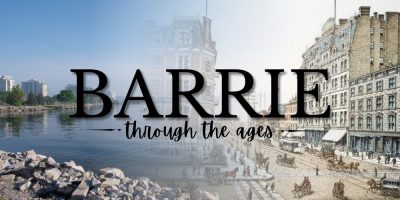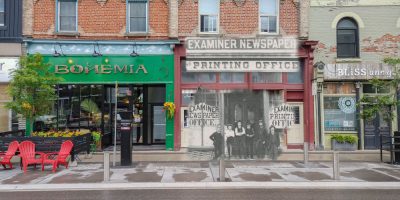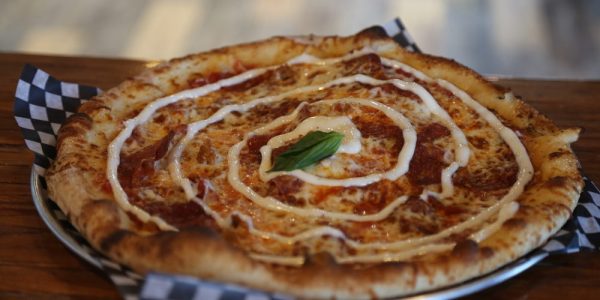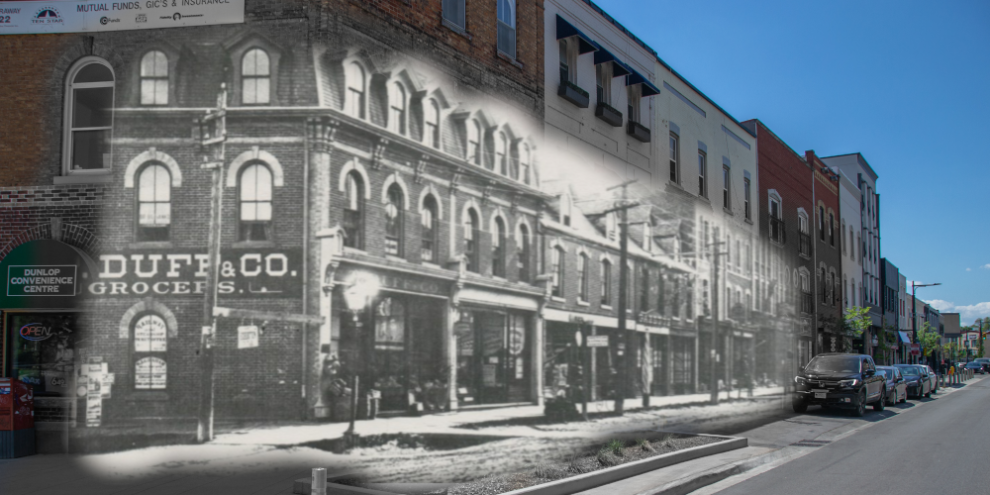
Glebe Block has had its fair share of ups and downs over its 150+ year history with ownership changes, dismantling, and several fires.
Today, Glebe Block is home to the Dunlop Convenience Center at 59 Dunlop St E and a number of other businesses between Memorial Square (previously railroad square, Station Gore, Post Office Square and Fred Grant Square) and Five Points.
Barrie's News Delivered To Your Inbox
By submitting this form, you are consenting to receive marketing emails from: Central Ontario Broadcasting, 431 Huronia Rd, Barrie, Ontario, CA, https://www.cobroadcasting.com. You can revoke your consent to receive emails at any time by using the SafeUnsubscribe® link, found at the bottom of every email. Emails are serviced by Constant Contact
How Glebe Block came to be
This property is aptly named as it started out as a glebe belonging to the Church of England. (A glebe is a land or property owned by a church used for benefice, earning income or other church activities.)
The land was allocated to the church in 1836, who decided to lease the property out for income rather than use it for religious purposes.
In 1852 the land passed to a private owner. At that time, the building here actually faced Kempenfelt Bay and not Dunlop Street, like it does today.
The fires that shaped Glebe Block
In 1868 the first of three fires would ravage the block. The fire, which began on the second floor in one of the Glebe Block units, destroyed many stores.
A little over three years later, in June 1871, another fire broke out. The fire, which was believed to have started in Railroad Square, was a pivotal event that left a lasting mark on the city’s growth.
It tore through the commercial district causing the widespread destruction to Glebe Block and other buildings in the Downtown Core, including the home of George Plaxton, Barrie's then Fire Chief.
The block was rebuilt that same year, with the store fronts facing Dunlop Street. While the original buildings had been constructed of wood, the new ones were built of stone, brick and/or roughcast plaster, thanks to a recent bill that aimed to prevent further widespread damage due to fire.
But this wasn't enough to save Glebe Block from fire's destructive path.
In 1875, a fire broke out on the North side of Dunlop. It spread across the street, destroying the roofs of the newly built Glebe Block.
Glebe Block businesses through the years
Today, the 1871 building still stand, though altered as a result of fire and Barrie's growth. The building currently standing at 59 Dunlop St E (Dunlop Convenience Center) and 55 Dunlop St E (Our House) is the same building was constructed by William Macy 1871.
It was originally built for Edwards & Laird, a store selling books, wallpaper, pianos and more, as well as a tailor named Humphrey Bennett.
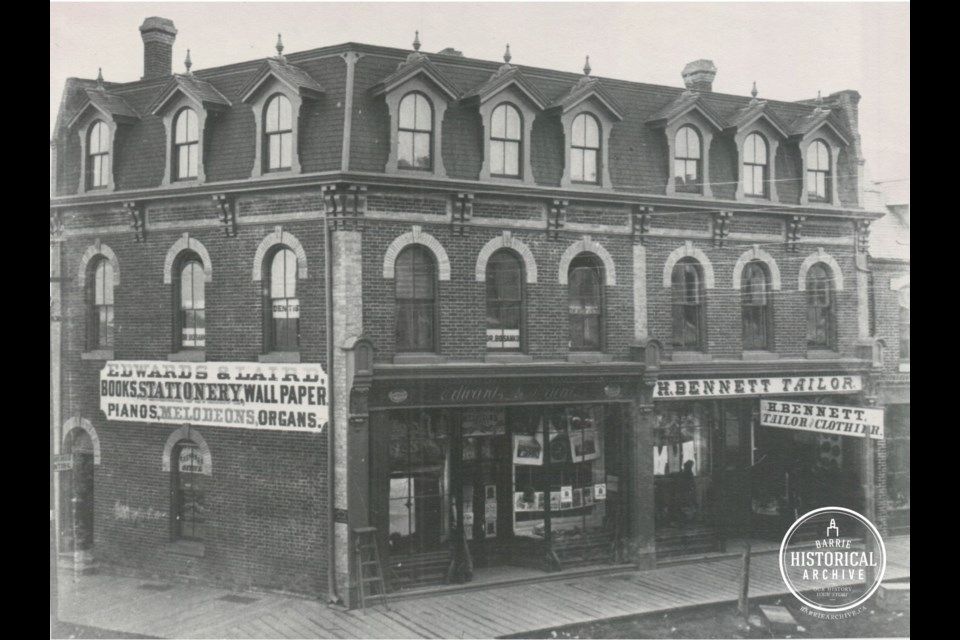
As time past, the block changed. This photograph from the Barrie Archive, shows Edwards & Laird becoming E.H. Edwards and H. Bennet Tailor/Clothier becoming Sanders Bros. Merchant Tailors.
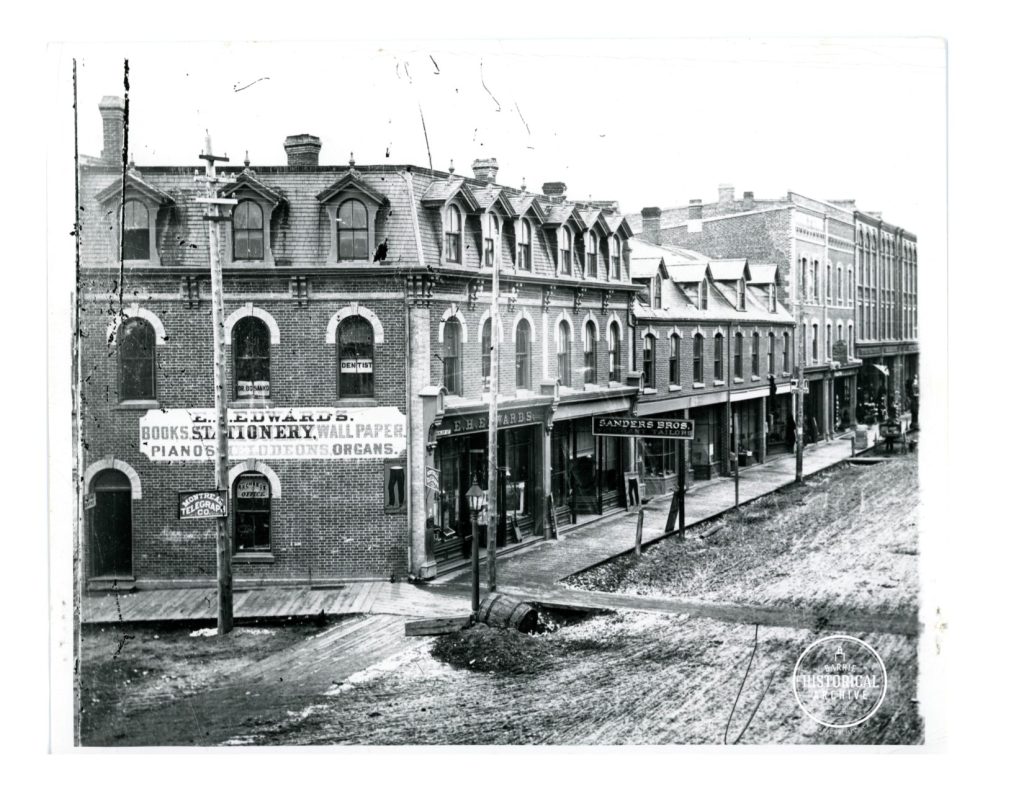
Soon after, T. Duff & Co. Grocers moved into the corner lot closest to the Square.
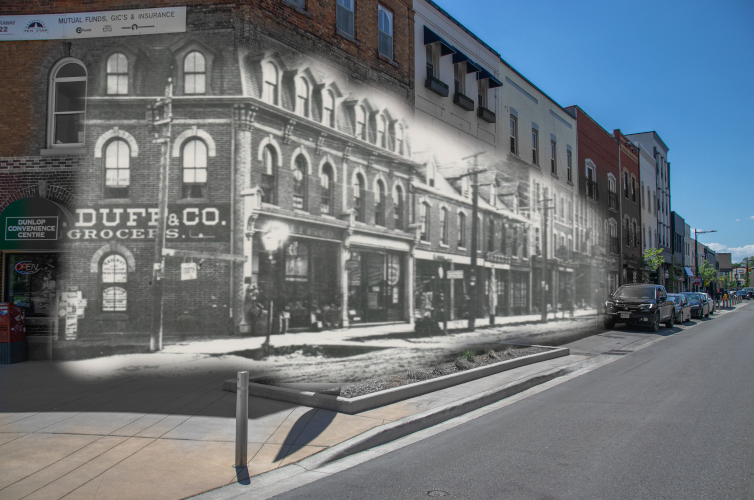
In 1881, this same unit would become J.C McKeggie and Co., a private bank. As you can see in the picture below, the original structure underwent construction around this time. The gable dormers were removed, the upper floor was squared off and a door was added to the side facing the square.
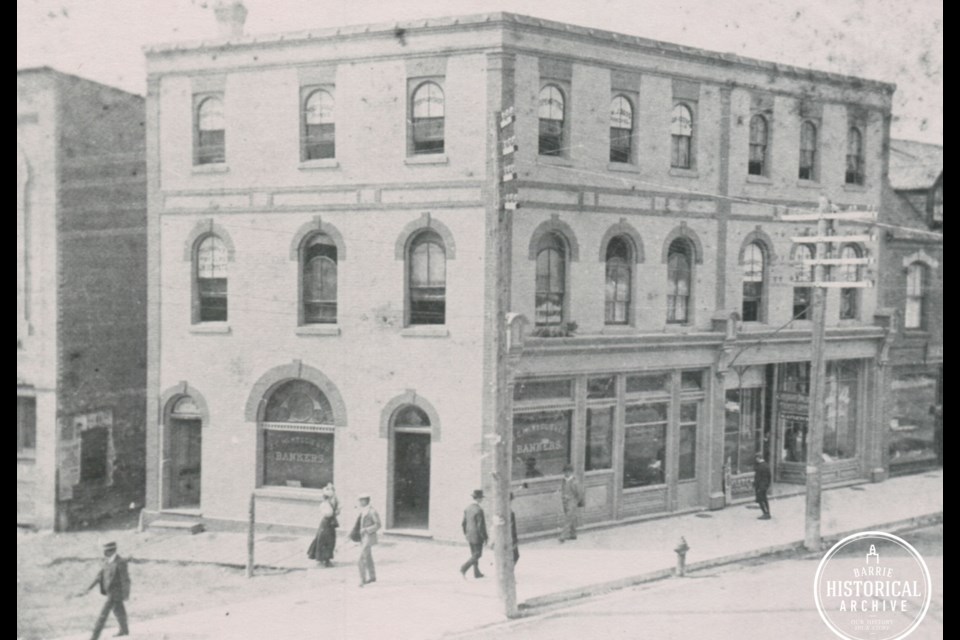
When McKeggie became ill, the bank became T.C. Beecroft & Co., which was run by McKeggie's former associate. Following Thomas Beecroft's death in 1930, the Glebe Block would change hands several more times. It would play host to H.W Payne and Company, followed by Jackson's Grill.
Jackson’s Grill: Where Barrie shared a cup and a story
Before fast food chains and drive-thrus became the norm, Jackson’s Grill was where Barrie paused.
It started with a woman named Neola Jackson, born Mary Neola Paddison in 1903. Though she left Barrie to train as a registered nurse and worked at an Ohio asylum, life eventually brought her home. After losing her husband, Clayton Jackson, in 1937, she returned to her roots and three years later, began building one of Barrie’s most beloved local spots.
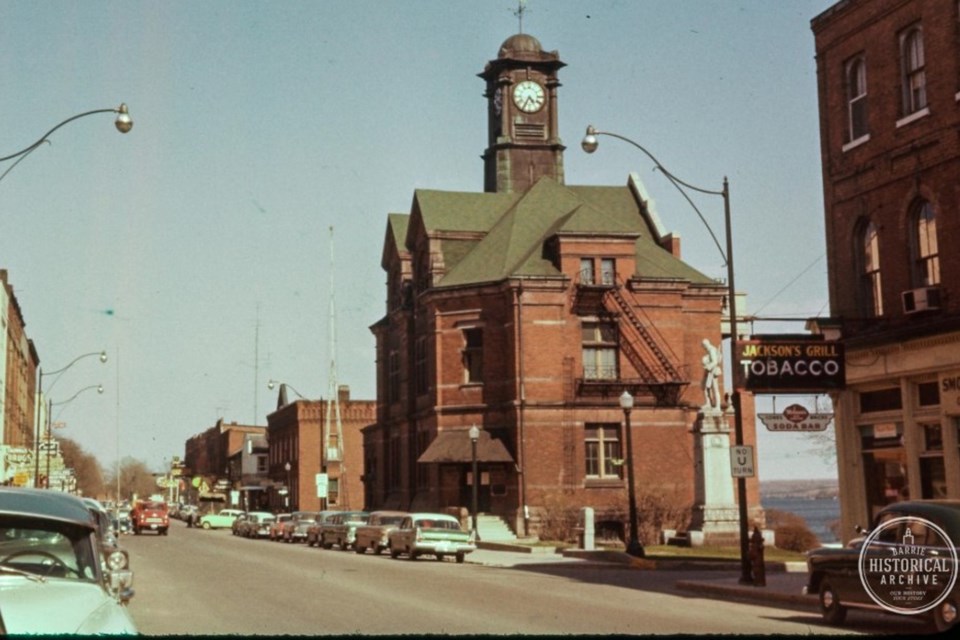
In 1940, Neola purchased the “soda bar grill and news stand” owned by H.W. Payne, planting the seeds for what would become Jackson’s Grill. With her warmth, work ethic, and no-nonsense charm, she turned a simple lunch counter into a local institution.
It wasn’t just the grilled cheese sandwiches or the “best cup of coffee in town” that brought people through the door. Jackson’s quickly became a social hub. It was a place where neighbours could catch up, workers could grab lunch, and kids could thumb through the latest comics while sipping on ice cream floats.
More than a coffee shop
In 1943, Neola married Frank Taylor, though the business never changed names. Jackson’s had become its own brand, synonymous with quality, comfort, and community.
Beyond the coffee and conversation, Jackson’s was a place where the excitement of a circus or a sold-out concert began. It was your one-stop-shop for tickets to just about anything happening in town.
But like many small, cherished places, Jackson’s Grill couldn’t last forever. In June 1977, the building was sold, and with it came the end of an era.
On their final day, the Taylors didn’t just lock up a storefront ... they said goodbye to generations of friends, customers, and memories. The day became an unofficial send-off, with longtime patrons stopping in one last time, not just for a coffee, but to say thank you.
Fire almost takes Glebe Block for a fourth time
On April 23, 1970, late in the afternoon, another fire nearly destroyed Glebe Block.
It began with a child, a match, and a moment of mischief that would ignite one of downtown Barrie’s most disruptive fires. Barrie's emergency response teams responded quickly. But as the first fire crews arrived, powerful winds worked against them.
Within an hour, flames had consumed multiple buildings east of the original blaze. By evening, the city had called in reinforcements.
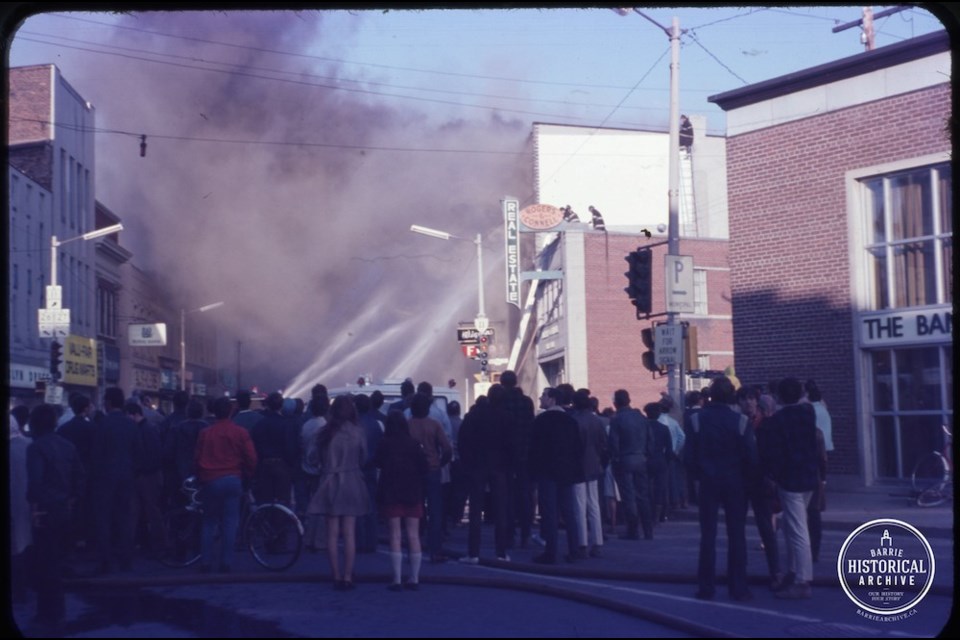
Fire departments from neighbouring towns raced to Barrie’s aid as crowds gathered to watch the drama unfold. The flames tore through part of the historic Glebe Block, engulfing street-level shops and apartment units alike.
Miraculously, the fire itself caused no fatalities ... but tragedy struck when a brick wall gave way. Several spectators were injured in the collapse. Thankfully, however, everyone recovered.
In total, two dozen residents were displaced, and businesses including Mel Brass, Laura Secord, and Household Finance were left damaged or destroyed. For many, it felt like the end of a chapter.
And yet, the city rallied.
Barrie shows the true power of community
Restaurants and grocers, including Burger Chef, Loblaws, & A&P, rushed to feed the responders. The Salvation Army parked a van near Five Points, serving coffee, distributing supplies, and updating worried loved ones. United Cigar Store opened its doors to firefighters, providing shelter as they battled the blaze into the night.
What could have been a moment of despair became a testament to community resilience.
In the aftermath, with 5,000 gallons of water soaked into the ruins, questions emerged about what to do next.
Some engineers proposed a full demolition of the damaged block. But inspections revealed that the lower levels of the buildings—some built on 1840s stone foundations—could be saved. This fire may have scorched its surface (and caused many building to lose an entire storey), but Glebe Block endured.
If you want to learn more about Glebe Block and all of Barrie’s history, head over to the Barrie Historical Archives, Barrie’s online museum. It’s full of pictures, videos, audio, and documents spanning nearly 200 years and it’s completely free!
Be sure to check back soon for more in our Barrie Through the Ages series and we'll also be updating this interactive map so you can explore Barrie’s history yourself!
RELATED: Learn more about Barrie's history ...


